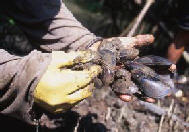|
They have traditionally gathered clams and mussels from the entire estuary, but shrimp farm expansion contributed to a decline in all local fisheries, since so many marine species depend on mangroves for at least part of their development.
"Fifteen years ago, one fisherman could collect about 500 mussels per day. Now, a man is lucky to find 100," said Lucio Cacao, president of one of the cooperatives participating in the project.
Freire explained that the local Port Authority gave the cooperatives custody of two tracts of mangroves on the condition that they preserve them. Using techniques developed in Spain, the fishermen are increasing clam and mussel populations within their areas for eventual commercial harvesting.
Cacao said the 120 hectare (296 acre) area his cooperative manages was a shrimp farm that went broke after floods destroyed its dikes. Because mangrove forests are extremely resilient, much of the farm reverted back to its natural state. Upon gaining custody of the area, the fishermen broke down remaining dikes so that the tide could spread mangrove seeds over the mudflats. They also planted mangroves on 18 hectares (44 acres) that were not regenerating naturally.
Ecuadorian worker helps restore mussel populations
(Photo courtesy GEF Small Grants Programme)
Under the direction of Freire, the fishermen have erected screen barriers to keep their mollusks from migrating to other parts of the estuary. They have also stocked their areas with small bivalves collected elsewhere, or purchased with funds from the GEF Small Grants Programme. Once the shellfish populations reach a certain size, they can begin a sustainable harvest.
An important component of the project is lowering predation. Since the biggest predator is man, each cooperative has built a guardhouse that members take turns staying in, to prevent other fishermen from filching their clams.
Though the mollusk populations are still recuperating, Freire believes they will be able to start harvesting commercially soon. The fishermen have traditionally depended on middlemen to market their shellfish, but recently they received training to help them market the shellfish directly to restaurants, which will further boost their incomes.
"We want this to become a small business," said Cacao. "We see it as something to pass on to our children."
|


